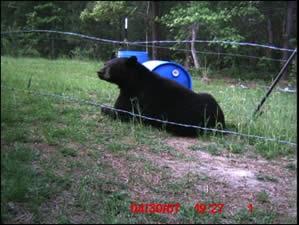August 10, 2016 - The Texas Black Alliance will hold their summer meeting on Thursday, August 25, at the Sabine National Forest District Office complex located a few miles east of Milam, Texas, along Highway 21.
The meeting will be held 10am to 3pm with a break for lunch and will provide members with updates on recent organizational activities as well as future actions needed to accomplish the organization’s mission as it expands its activities across Texas. Dave Holdermann, wildlife diversity biologist with the Texas Parks and Wildlife Department, will also provide the organization with an update of potential black bear sightings currently under investigation in the East Texas region, while Texas Parks and Wildlife Department biologist Jonah Evans will cover statewide black bear conservation and management issues. Representatives from the U.S. Forest Service will speak on their forest planning process, as it will affect the future of black bears in the forests of East Texas.
 The black bear, whose historic range once spanned nearly all of Texas, has begun to reappear in portions of its native Texas territory after original populations were devastated by loss of habitat and over harvesting throughout the 19th and 20th centuries. This re-emergence is due in large part to the movements of black bears from the bordering states of Louisiana, Arkansas, Oklahoma and New Mexico plus the country of Mexico. The growing and expanding black bear populations in adjacent states have resulted in a natural, slow return of the native species in small numbers to Texas. It remains illegal to kill or harm a black bear in Texas, with violations carrying significant fines, jail time and/or loss of hunting privileges.
The black bear, whose historic range once spanned nearly all of Texas, has begun to reappear in portions of its native Texas territory after original populations were devastated by loss of habitat and over harvesting throughout the 19th and 20th centuries. This re-emergence is due in large part to the movements of black bears from the bordering states of Louisiana, Arkansas, Oklahoma and New Mexico plus the country of Mexico. The growing and expanding black bear populations in adjacent states have resulted in a natural, slow return of the native species in small numbers to Texas. It remains illegal to kill or harm a black bear in Texas, with violations carrying significant fines, jail time and/or loss of hunting privileges.
“We aim to educate the public about this native Texas species through sound, scientific research,” said Nathan Garner, interim chair of the bear alliance. “The black bear has a rich and storied history in Texas, and we’re confident that a well-informed public is key to this native species’ natural return.”
Texas Parks and Wildlife began documenting black bear sightings and deaths throughout Texas in 1977, and since that time, the number of sightings has increased in portions of Texas. To address the potential return of this native Texas species, the Texas Black Bear Alliance was formed as a non-profit coalition of individuals representing state and federal agencies as well as the private industry and private citizens including landowners. The organization seeks to support the restoration of black bears in suitable habitats throughout its historic range in Texas through cooperative partnerships, education, research, habitat management and the creation of a well-informed public.
As black bears are still considered rare in Texas, wildlife biologists from Texas Parks and Wildlife investigate alleged bear sightings to confirm or refute the observation. After the investigation concludes, sightings are divided into one of three classifications. Landowners are in no way obligated to implement any sort of special management practice if a sighting is reported on their land. To report a possible bear sighting in East Texas, call Texas Parks and Wildlife at (512) 389-4505.
Those interested in learning more about the organization and its mission are welcome to attend the summer meeting. Information regarding black bears in Texas, as well as the Texas Black Bear Alliance, can also be found on the organization’s Facebook page.









